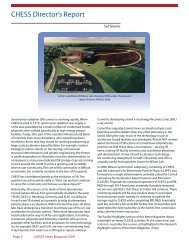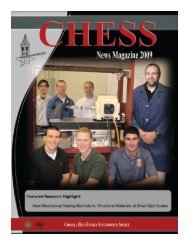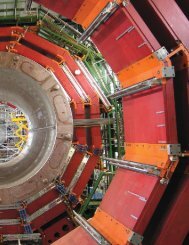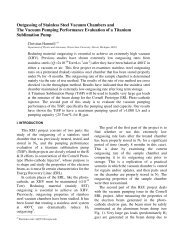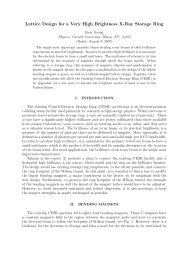Analysis and Optimization of Singular Value Decomposition Orbit ...
Analysis and Optimization of Singular Value Decomposition Orbit ...
Analysis and Optimization of Singular Value Decomposition Orbit ...
You also want an ePaper? Increase the reach of your titles
YUMPU automatically turns print PDFs into web optimized ePapers that Google loves.
2<br />
FIG. 1: Quadrupole Misalignment<br />
III.<br />
GENERALIZED RESPONSE<br />
MATRICES<br />
FIG. 2: RF cavity pitch<br />
an effective dipole field. For a quadrupole magnet<br />
with a center shifted from the origin to<br />
(δx, δy), it effectively steers a particle beam by<br />
∆θ x = k l δx (1)<br />
∆θ y = −k l δy (2)<br />
where k l is the integrated quadrupole strength<br />
[6].<br />
An RF cavity accelerates a particle beam longitudinally,<br />
but if it has a pitch angle, it introduces<br />
a transverse acceleration leading to deflections<br />
<strong>and</strong> emittance growth. A cavity with a pitch<br />
angle ϕ generates an effective steering<br />
∆θ ≈ ∆P<br />
P<br />
ϕ, (3)<br />
where P is the final on-axis momentum <strong>and</strong> ∆P<br />
is the momentum gain [6].<br />
The dipole fields bend the beam around the designed<br />
trajectory, but errors in this field can easily<br />
result in a different bending radius, deflecting<br />
the beam away from the reference orbit.<br />
After the identification <strong>of</strong> these error sources,<br />
the right coefficients map them to the appropriate<br />
spaces such as the orbit monitor space,<br />
<strong>and</strong> the mapping is done through generalized response<br />
matrices. Response matrices relate a specific<br />
action imparted by an actuator A with its<br />
result to a responder R defined by the equation<br />
R = M RA A, where M RA is the response coeffecient<br />
[3]. This relation may be further exp<strong>and</strong>ed<br />
to include m responders <strong>and</strong> n actuators represented<br />
by column vectors.<br />
There are several generalized response matrices<br />
crucial for the analyses. The error-to-monitor<br />
response matrix M EM relates all potential error<br />
sources to the orbit disturbance at the monitors.<br />
A similar matrix, M EA , summarizes the<br />
orbit errors at all representative elements. These<br />
matrices must include all major potential error<br />
sources that the system is designed to correct.<br />
Another pair <strong>of</strong> response matrices are the<br />
corrector-to-monitor M CM <strong>and</strong> corrector-to-alllocation<br />
M CA matrices. These describe the orbit<br />
disturbances caused by the angle kicks from<br />
the correctors. For the purpose <strong>of</strong> corrector optimization,<br />
it helps to construct two other response<br />
matrices. The first is the response matrix<br />
M AM which represents the orbit error at<br />
the monitors due to angle kicks at all representative<br />
elements (i.e. magnetic elements, mainly<br />
the quadrupoles). It provides a list <strong>of</strong> potential<br />
new correctors <strong>and</strong> its contribution to orbits at<br />
the monitors. Finally, the matrix M AA takes<br />
the same actuators but propagates its effects to<br />
all locations. These response matrices with their<br />
respective actuators <strong>and</strong> responders are summarized<br />
in Table I.<br />
To generate these response matrices, Tao has<br />
a comm<strong>and</strong> that immediately calculates the<br />
derivative dModel V alue/dV ariable [4] which<br />
determines how a change in a variable affect a<br />
data. Each derivative becomes the coefficient<br />
M ij between the i-th responder <strong>and</strong> the j-th<br />
actuator. One only needs to use the appropriate<br />
data (responders) <strong>and</strong> variable (actuators) in<br />
TAO <strong>and</strong> construct the matrix from the derivative.<br />
For example, M CM is formed from the




